Autonomous Hazardous Gas Detection Systems: A Systematic Review
Abstract
1. Introduction
2. The Landscape of Gas Hazards in Semiconductor Wafer Fabrication Facilities
2.1. The Nature of Hazardous Specialty Gases
2.2. Process-Specific Risks and Chemical Hazards
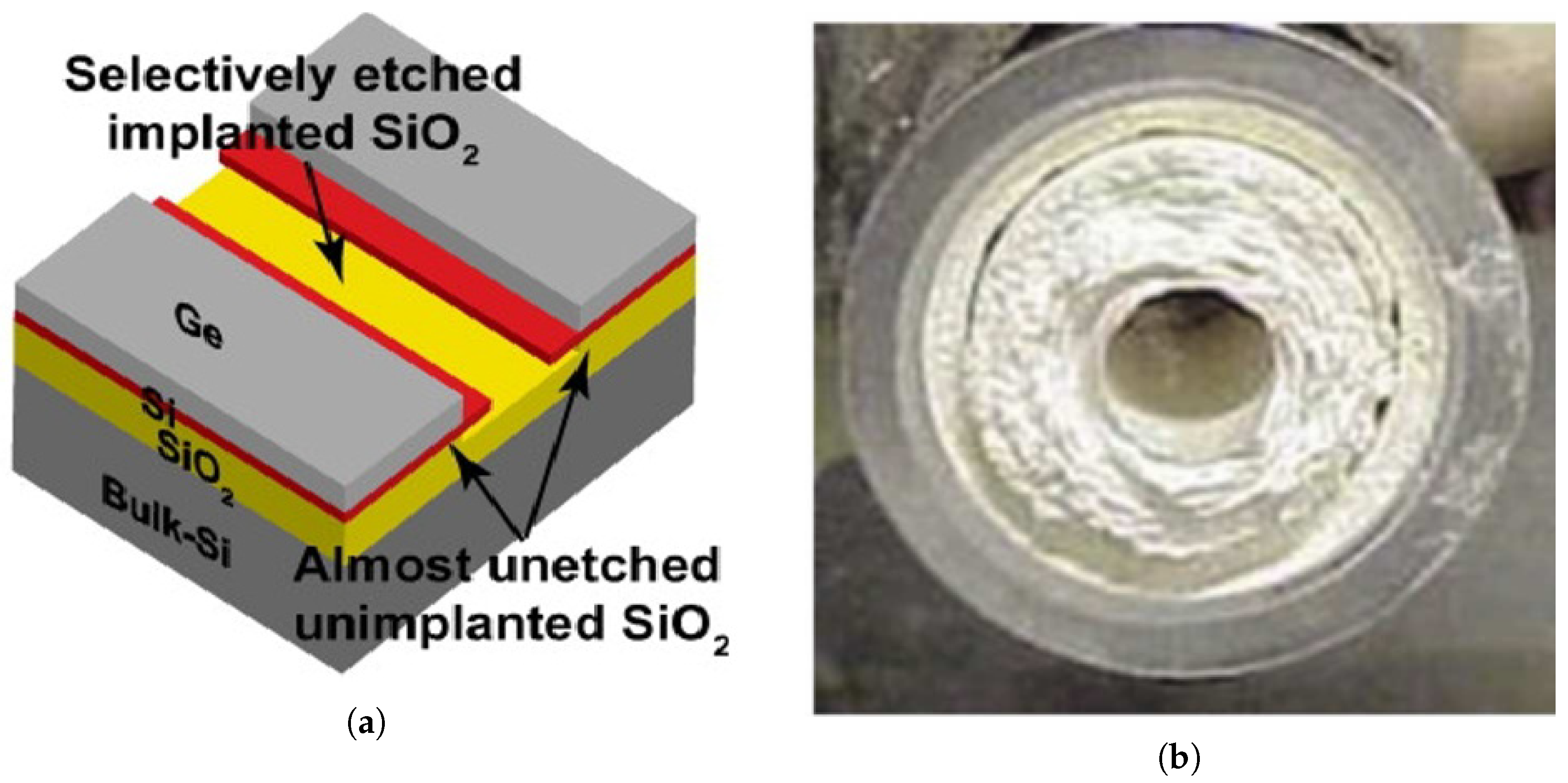
2.3. Gas Sensor Technologies and Current Calibration Practices
3. Methodology
3.1. Information Sources and Search Strategy
3.2. Study Selection and Data Extraction
3.3. Synthesis of Results
4. Comprehensive Systematic Review
4.1. Sensor Accuracy Drift and Dataset Limitations
4.2. Calibration Methodologies for Low-Cost Sensors
4.3. Application-Specific Deployments and Environmental Variable Studies
4.4. Early Fire Detection Using Gas Sensor Data
5. The Research Gap and Future Research Direction
5.1. The Research Gap
5.2. Future Research Direction
5.2.1. Development of Application-Specific Datasets
5.2.2. Quantitative Modeling of Real World Gas Exposure vs. Sensor Response Drift
5.2.3. Harmonizing Low-Cost Sensor Outputs with Industrial Grade Benchmark Standards
6. Conclusions
Author Contributions
Funding
Data Availability Statement
Acknowledgments
Conflicts of Interest
References
- Lee, J.H.; Kim, Y.; Kim, I.; Hong, S.B.; Yun, H.S. Comparative Analysis of Ultrasonic and Traditional Gas-Leak Detection Systems in the Process Industries: A Monte Carlo Approach. Processes 2023, 12, 67. [Google Scholar] [CrossRef]
- Eze, J. Development of a Framework for Integrated Oil and Gas Pipeline Monitoring and Incident Mitigation System (IOPMIMS). Ph.D Thesis, University of Wolverhampton, Wolverhampton, UK, 2017. [Google Scholar]
- Liu, X.; Cheng, S.; Liu, H.; Hu, S.; Zhang, D.; Ning, H. A survey on gas sensing technology. Sensors 2012, 12, 9635–9665. [Google Scholar] [CrossRef] [PubMed]
- Spinelle, L.; Gerboles, M.; Villani, M.G.; Aleixandre, M.; Bonavitacola, F. Field calibration of a cluster of low-cost available sensors for air quality monitoring. Part A: Ozone and nitrogen dioxide. Sens. Actuators B Chem. 2015, 215, 249–257. [Google Scholar] [CrossRef]
- Nakagawa, H.; Okazaki, S.; Asakura, S.; Fukuda, K.; Akimoto, H.; Takahashi, S.; Shigemori, S. An automated car ventilation system. Sens. Actuators B Chem. 2000, 65, 133–137. [Google Scholar] [CrossRef]
- Carotta, M.C.; Martinelli, G.; Crema, L.; Gallana, M.; Merli, M.; Ghiotti, G.; Traversa, E. Array of thick film sensors for atmospheric pollutant monitoring. Sens. Actuators B Chem. 2000, 68, 1–8. [Google Scholar] [CrossRef]
- Marco, S.; Gutierrez-Galvez, A. Signal and Data Processing for Machine Olfaction and Chemical Sensing: A Review. IEEE Sens. J. 2012, 12, 3189–3214. [Google Scholar] [CrossRef]
- Tsai, W.T. Environmental and health risks of chlorine trifluoride (ClF3), an alternative to potent greenhouse gases in the semiconductor industry. J. Hazard. Mater. 2011, 190, 1–7. [Google Scholar] [CrossRef]
- Acute Exposure Guideline Levels for Selected Airborne Chemicals. Available online: https://nap.nationalacademies.org/catalog/12978/acute-exposure-guideline-levels-for-selected-airborne-chemicals-volume-9 (accessed on 15 October 2025).
- Clark, J.D. Ignition!: An Informal History of Liquid Rocket Propellants; Rutgers University Press: New Brunswick, NJ, USA, 1972. [Google Scholar]
- Carson, P.A. Hazardous Chemicals Handbook; Elsevier: Amsterdam, The Netherlands, 2002. [Google Scholar]
- Tennebroek, R.; van der Hoeven-van Casteren, I.; Swaans, R.; van der Slot, S.; Stals, P.J.; Tuijtelaars, B.; Koning, C. Water-based polyurethane dispersions. Polym. Int. 2019, 68, 832–842. [Google Scholar] [CrossRef]
- Chang, Y.Y.; Peng, D.J.; Wu, H.C.; Tsaur, C.C.; Shen, C.C.; Tsai, H.Y.; Chen, J.R. Revisiting of a silane explosion in a photovoltaic fabrication plant. Process Saf. Prog. 2007, 26, 155–158. [Google Scholar] [CrossRef]
- Biello, D. Explosive Silicon Gas Casts Shadow on Solar Power Industry. Available online: https://www.scientificamerican.com/article/explosive-gas-silane-used-to-make-photovoltaics/ (accessed on 15 October 2025).
- Vasilev, V.Y.; Repinsky, S.M. Chemical vapour deposition of thin-film dielectrics. Russ. Chem. Rev. 2005, 74, 413. [Google Scholar] [CrossRef]
- Cao, G.; Wang, Y. Nanostructures and nanomaterials: Synthesis. Prop. Appl. 2004, 2, 94. [Google Scholar]
- Liu, J.; Tai, Y.C.; Lee, J.; Pong, K.C.; Zohar, Y.; Ho, C.M. In situ monitoring and universal modelling of sacrificial PSG etching using hydrofluoric acid. In Proceedings of the [1993] Proceedings IEEE Micro Electro Mechanical Systems, Fort Lauderdale, FL, USA, 10 February 1993; pp. 71–76. [Google Scholar] [CrossRef]
- Arnó, J.; Farha, O.K.; Morris, W.; Siu, P.W.; Tom, G.M.; Weston, M.H.; Fuller, P.E. ION-X Dopant Gas Delivery System Performance Characterization at Axcelis. In Proceedings of the 2018 22nd International Conference on Ion Implantation Technology (IIT), Wurzburg, Germany, 16–21 September 2018; pp. 227–230. [Google Scholar] [CrossRef]
- Chambers, A. Managing hazardous process exhausts in high volume manufacturing (HVM) of advanced devices. In Proceedings of the 2016 China Semiconductor Technology International Conference (CSTIC), Shanghai, China, 13–14 March 2016; IEEE: New York, NY, USA, 2016; pp. 1–3. [Google Scholar]
- Passi, V.; Sodervall, U.; Nilsson, B.; Petersson, G.; Hagberg, M.; Krzeminski, C.; Dubois, E.; Bois, B.D.; Raskin, J.P. Anisotropic vapor HF etching of silicon dioxide for Si microstructure release. Microelectron. Eng. 2012, 95, 83–89. [Google Scholar] [CrossRef]
- Chelton, C.; Glowatz, M.; Mosovsky, J. Chemical hazards in the semiconductor industry. IEEE Trans. Educ. 1991, 34, 269–288. [Google Scholar] [CrossRef]
- Fonollosa, J.; Rodriguez-Lujan, I.; Shevade, A.V.; Homer, M.L.; Ryan, M.A.; Huerta, R. Human activity monitoring using gas sensor arrays. Sens. Actuators B Chem. 2014, 199, 398–402. [Google Scholar] [CrossRef]
- Smaby, N.; Johanson, M.; Baker, B.; Kenney, D.; Murray, W.; Hentz, V. Identification of key pinch forces required to complete functional tasks. J. Rehabil. Res. Dev. 2004, 41, 215–224. [Google Scholar] [CrossRef]
- Shevade, A.; Ryan, M.; Homer, M.; Manfreda, A.; Zhou, H.; Manatt, K. Molecular modeling of polymer composite–analyte interactions in electronic nose sensors. Sens. Actuators B Chem. 2003, 93, 84–91, Proceedings of the Ninth International Meeting on Chemical Sensors. [Google Scholar] [CrossRef] [PubMed]
- Shevade, A.V.; Homer, M.L.; Taylor, C.J.; Zhou, H.; Jewell, A.D.; Manatt, K.S.; Kisor, A.K.; Yen, S.P.S.; Ryan, M.A. Correlating Polymer-Carbon Composite Sensor Response with Molecular Descriptors. J. Electrochem. Soc. 2006, 153, H209. [Google Scholar] [CrossRef]
- Isaac, N.; Pikaar, I.; Biskos, G. Metal oxide semiconducting nanomaterials for air quality gas sensors: Operating principles, performance, and synthesis techniques. Microchim. Acta 2022, 189, 196. [Google Scholar] [CrossRef]
- Austin, C.C.; Roberge, B.; Goyer, N. Cross-sensitivities of electrochemical detectors used to monitor worker exposures to airborne contaminants: False positive responses in the absence of target analytes. J. Environ. Monit. 2006, 8, 161–166. [Google Scholar] [CrossRef] [PubMed]
- Kunimoto, A.; Abe, N.; Uchida, H.; Katsube, T. Highly sensitive semiconductor NOx gas sensor operating at room temperature. Sens. Actuators B Chem. 2000, 65, 122–124. [Google Scholar] [CrossRef]
- Ishiji, T.; Iijima, T.; Takahashi, K. Electrochemical sensing of arsine and silane by the amperometric gas sensor using gold electrode. Denki Kagaku Oyobi Kogyo Butsuri Kagaku 1996, 64, 1304–1310. [Google Scholar] [CrossRef]
- Mizutani, Y.; Matsuda, H.; Ishiji, T.; Furuya, N.; Takahashi, K. Improvement of electrochemical NO2 sensor by use of carbon–fluorocarbon gas permeable electrode. Sens. Actuators B Chem. 2005, 108, 815–819. [Google Scholar] [CrossRef]
- Wu, R.; Tian, L.; Li, H.; Liu, H.; Luo, J.; Tian, X.; Hua, Z.; Wu, Y.; Fan, S. A selective methane gas sensor based on metal oxide semiconductor equipped with an on-chip microfilter. Sens. Actuators B Chem. 2022, 359, 131557. [Google Scholar] [CrossRef]
- Baalisampang, T.; Abbassi, R.; Garaniya, V.; Khan, F.; Dadashzadeh, M. Review and analysis of fire and explosion accidents in maritime transportation. Ocean Eng. 2018, 158, 350–366. [Google Scholar] [CrossRef]
- Stojiljkovic, E.; Grozdanovic, M. Human reliability assessment–A serbian experience. IETI Trans. Ergon. Saf. 2022, 6, 24–33. [Google Scholar]
- Lösch, M.; Baumbach, M.; Schütze, A. Ozone detection in the ppb-range with improved stability and reduced cross sensitivity. Sens. Actuators B Chem. 2008, 130, 367–373, Proceedings of the Eleventh International Meeting on Chemical Sensors IMCS-11. [Google Scholar] [CrossRef]
- Gramm, A.; Schütze, A. High performance solvent vapor identification with a two sensor array using temperature cycling and pattern classification. Sens. Actuators B Chem. 2003, 95, 58–65, Selected Papers from Eurosensors XVI. [Google Scholar] [CrossRef]
- Kamionka, M.; Breuil, P.; Pijolat, C. Calibration of a multivariate gas sensing device for atmospheric pollution measurement. Sens. Actuators B Chem. 2006, 118, 323–327, Eurosensors XIX. [Google Scholar] [CrossRef]
- Kamionka, M.; Breuil, P.; Pijolat, C. Atmospheric pollution measurement with a multi-materials sensing device. Mater. Sci. Eng. C 2006, 26, 290–296, Selected Papers Presented at the MADICA 2004 Conference, Fourth Maghreb-Europe Meeting on Materials and their Applications for Devices and Physical, Chemical and Biological Sensors Tunis-Ghammart, Tunisia, 29 November–1 December 2004. [Google Scholar] [CrossRef]
- Haddaway, N.R.; Page, M.J.; Pritchard, C.C.; McGuinness, L.A. PRISMA2020: An R package and Shiny app for producing PRISMA 2020-compliant flow diagrams, with interactivity for optimised digital transparency and Open Synthesis. Campbell Syst. Rev. 2022, 18, e1230. [Google Scholar] [CrossRef]
- Maho, P.; Herrier, C.; Livache, T.; Comon, P.; Barthelmé, S. A calibrant-free drift compensation method for gas sensor arrays. Chemom. Intell. Lab. Syst. 2022, 225, 104549. [Google Scholar] [CrossRef]
- Se, H.; Song, K.; Sun, C.; Jiang, J.; Liu, H.; Wang, B.; Wang, X.; Zhang, W.; Liu, J. Online drift compensation framework based on active learning for gas classification and concentration prediction. Sens. Actuators B Chem. 2024, 398, 134716. [Google Scholar] [CrossRef]
- Cai, M.; Xu, S.; Zhou, X.; Lu, H.; Liang, X. A Study on the Effect of Drift Factor on Feature Optimization in Electronic Nose Detection. Appl. Sci. 2024, 14. [Google Scholar] [CrossRef]
- Feng, L.; Dai, H.; Song, X.; Liu, J.; Mei, X. Gas identification with drift counteraction for electronic noses using augmented convolutional neural network. Sens. Actuators B Chem. 2022, 351, 130986. [Google Scholar] [CrossRef]
- Vergara, A. Gas Sensor Array Drift Dataset. UCI Machine Learning Repository. 2012. [Google Scholar] [CrossRef]
- Dennler, N.; Rastogi, S.; Fonollosa, J.; Van Schaik, A.; Schmuker, M. Drift in a popular metal oxide sensor dataset reveals limitations for gas classification benchmarks. Sens. Actuators B Chem. 2022, 361, 131668. [Google Scholar] [CrossRef]
- Dennler, N.; Rastogi, S.; Fonollosa, J.; van Schaik, A.; Schmuker, M. Drift in a Popular Metal Oxide Sensor Dataset Reveals Limitations for Gas Classification Benchmarks. arXiv 2021, arXiv:2108.08793. [Google Scholar] [CrossRef]
- Tancev, G. Relevance of Drift Components and Unit-to-Unit Variability in the Predictive Maintenance of Low-Cost Electrochemical Sensor Systems in Air Quality Monitoring. Sensors 2021, 21, 3298. [Google Scholar] [CrossRef] [PubMed]
- Yang, C.; Bohlin, G.; Oechtering, T. Environmental Variation or Instrumental Drift? A Probabilistic Approach to Gas Sensor Drift Modeling and Evaluation. In Proceedings of the 2024 IEEE SENSORS, Kobe, Japan, 20–23 October 2024; pp. 1–4. [Google Scholar] [CrossRef]
- Fonollosa, J.; Rodríguez-Luján, I.; Trincavelli, M.; Huerta, R. Dataset from chemical gas sensor array in turbulent wind tunnel. Data Brief 2015, 3, 169–174. [Google Scholar] [CrossRef]
- Vergara, A.; Fonollosa, J.; Mahiques, J.; Trincavelli, M.; Rulkov, N.; Huerta, R. On the performance of gas sensor arrays in open sampling systems using Inhibitory Support Vector Machines. Sens. Actuators B Chem. 2013, 185, 462–477. [Google Scholar] [CrossRef]
- Fonollosa, J.; Fernández, L.; Huerta, R.; Gutiérrez-Gálvez, A.; Marco, S. Temperature optimization of metal oxide sensor arrays using mutual information. Sens. Actuators B Chem. 2013, 187, 331–339. [Google Scholar] [CrossRef]
- Karagulian, F.; Barbiere, M.; Kotsev, A.; Spinelle, L.; Gerboles, M.; Lagler, F.; Redon, N.; Crunaire, S.; Borowiak, A. Review of performance of Low-cost Sensors for Air Quality Monitoring. Atmosphere 2019, 10, 506, (online). [Google Scholar] [CrossRef]
- Zuidema, C.; Schumacher, C.S.; Austin, E.; Carvlin, G.; Larson, T.V.; Spalt, E.W.; Zusman, M.; Gassett, A.J.; Seto, E.; Kaufman, J.D.; et al. Deployment, calibration, and cross-validation of low-cost electrochemical sensors for carbon monoxide, nitrogen oxides, and ozone for an epidemiological study. Sensors 2021, 21, 4214. [Google Scholar] [CrossRef]
- TD1105 - European Network on New Sensing Technologies for Air-Pollution Control and Environmental Sustainability—EuNetAir. Available online: https://www.cost.eu/actions/TD1105/ (accessed on 15 October 2025).
- Lyons, T.J.; Scott, W.D. Principles of Air Pollution Meteorology. Available online: https://books.google.com.my/books/about/Principles_of_Air_Pollution_Meteorology.html?id=UyBZjgEACAAJ&redir_esc=y (accessed on 15 October 2025).
- Alloway, B.; Ayres, D.C. Chemical Principles of Environmental Pollution; CRC Press: Boca Raton, FL, USA, 1997. [Google Scholar]
- Bloomfield, P.; Royle, J.; Steinberg, L.J.; Yang, Q. Accounting for meteorological effects in measuring urban ozone levels and trends. Atmos. Environ. 1996, 30, 3067–3077. [Google Scholar] [CrossRef]
- Martinelli, E.; Magna, G.; De Vito, S.; Di Fuccio, R.; Di Francia, G.; Vergara, A.; Di Natale, C. An adaptive classification model based on the Artificial Immune System for chemical sensor drift mitigation. Sens. Actuators B Chem. 2013, 177, 1017–1026. [Google Scholar] [CrossRef]
- De Vito, S.; Esposito, E.; Salvato, M.; Popoola, O.; Formisano, F.; Jones, R.; Di Francia, G. Calibrating chemical multisensory devices for real world applications: An in-depth comparison of quantitative machine learning approaches. Sens. Actuators B Chem. 2018, 255, 1191–1210. [Google Scholar] [CrossRef]
- D’Amico, A.; Di Natale, C.; Paolesse, R.; Macagnano, A.; Martinelli, E.; Pennazza, G.; Santonico, M.; Bernabei, M.; Roscioni, C.; Galluccio, G.; et al. Olfactory systems for medical applications. Sens. Actuators B Chem. 2008, 130, 458–465, Proceedings of the Eleventh International Meeting on Chemical Sensors IMCS-11. [Google Scholar] [CrossRef]
- Hossein-Babaei, F.; Ghafarinia, V. Compensation for the drift-like terms caused by environmental fluctuations in the responses of chemoresistive gas sensors. Sens. Actuators B Chem. 2010, 143, 641–648. [Google Scholar] [CrossRef]
- Pathange, L.P.; Mallikarjunan, P.; Marini, R.P.; O’Keefe, S.; Vaughan, D. Non-destructive evaluation of apple maturity using an electronic nose system. J. Food Eng. 2006, 77, 1018–1023. [Google Scholar] [CrossRef]
- Endres, H.E.; Göttler, W.; Hartinger, R.; Drost, S.; Hellmich, W.; Müller, G.; v. Braunmühl, C.; Krenkow, A.; Perego, C.; Sberveglieri, G. A thin-film SnO2 sensor system for simultaneous detection of CO and NO2 with neural signal evaluation. Sens. Actuators B Chem. 1996, 36, 353–357, Proceedings of the Sixth International Meeting on Chemical Sensors. [Google Scholar] [CrossRef]
- Yi, Z. Discriminative dimensionality reduction for sensor drift compensation in electronic nose: A robust, low-rank, and sparse representation method. Expert Syst. Appl. 2020, 148, 113238. [Google Scholar] [CrossRef]
- Yan, K.; Zhang, D. Calibration transfer and drift compensation of e-noses via coupled task learning. Sens. Actuators B Chem. 2016, 225, 288–297. [Google Scholar] [CrossRef]
- Di Carlo, S.; Falasconi, M. Drift Correction Methods for Gas Chemical Sensors in Artificial Olfaction Systems: Techniques and Challenges; INTECH Open Access Publisher: London, UK, 2012. [Google Scholar]
- Vergara, A.; Vembu, S.; Ayhan, T.; Ryan, M.A.; Homer, M.L.; Huerta, R. Chemical gas sensor drift compensation using classifier ensembles. Sens. Actuators B Chem. 2012, 166–167, 320–329. [Google Scholar] [CrossRef]
- Feudale, R.N.; Woody, N.A.; Tan, H.; Myles, A.J.; Brown, S.D.; Ferré, J. Transfer of multivariate calibration models: A review. Chemom. Intell. Lab. Syst. 2002, 64, 181–192. [Google Scholar] [CrossRef]
- de Noord, O.E. Multivariate calibration standardization. Chemom. Intell. Lab. Syst. 1994, 25, 85–97. [Google Scholar] [CrossRef]
- Wold, S.; Antti, H.; Lindgren, F.; Öhman, J. Orthogonal signal correction of near-infrared spectra. Chemom. Intell. Lab. Syst. 1998, 44, 175–185. [Google Scholar] [CrossRef]
- Tomic, O.; Ulmer, H.; Haugen, J.E. Standardization methods for handling instrument related signal shift in gas-sensor array measurement data. Anal. Chim. Acta 2002, 472, 99–111. [Google Scholar] [CrossRef]
- Zhang, L.; Tian, F.; Kadri, C.; Xiao, B.; Li, H.; Pan, L.; Zhou, H. On-line sensor calibration transfer among electronic nose instruments for monitoring volatile organic chemicals in indoor air quality. Sens. Actuators B Chem. 2011, 160, 899–909. [Google Scholar] [CrossRef]
- Deshmukh, S.; Bandyopadhyay, R.; Bhattacharyya, N.; Pandey, R.; Jana, A. Application of electronic nose for industrial odors and gaseous emissions measurement and monitoring—An overview. Talanta 2015, 144, 329–340. [Google Scholar] [CrossRef] [PubMed]
- Yan, K.; Zhang, D. Improving the transfer ability of prediction models for electronic noses. Sens. Actuators B Chem. 2015, 220, 115–124. [Google Scholar] [CrossRef]
- Yan, J.; Chen, F.; Liu, T.; Zhang, Y.; Peng, X.; Yi, D.; Duan, S. Subspace alignment based on an extreme learning machine for electronic nose drift compensation. Knowl.-Based Syst. 2022, 235, 107664. [Google Scholar] [CrossRef]
- Capelli, L.; Sironi, S.; Del Rosso, R. Electronic Noses for Environmental Monitoring Applications. Sensors 2014, 14, 19979–20007. [Google Scholar] [CrossRef]
- Zhu, H.; Wu, Y.; Yang, G.; Song, R.; Yu, J.; Zhang, J. Electronic Nose Drift Suppression Based on Smooth Conditional Domain Adversarial Networks. Sensors 2024, 24, 1319. [Google Scholar] [CrossRef]
- Fonollosa, J.; Fernandez, L.; Gutiérrez-Gálvez, A.; Huerta, R.; Marco, S. Calibration transfer and drift counteraction in chemical sensor arrays using Direct Standardization. Sens. Actuators B Chem. 2016, 236, 1044–1053. [Google Scholar] [CrossRef]
- Sandnes, A.T.; Grimstad, B.; Kolbjørnsen, O. Multi-task neural networks by learned contextual inputs. Neural Netw. 2024, 179, 106528. [Google Scholar] [CrossRef]
- Ruiz, C.; Alaíz, C.M.; Dorronsoro, J.R. A survey on kernel-based multi-task learning. Neurocomputing 2024, 577, 127255. [Google Scholar] [CrossRef]
- Liu, T.; Li, D.; Chen, Y.; Wu, M.; Yang, T.; Cao, J. Online Drift Compensation by Adaptive Active Learning on Mixed Kernel for Electronic Noses. Sens. Actuators B Chem. 2020, 316, 128065. [Google Scholar] [CrossRef]
- Kadri, C.; Tian, F.; Zhang, L.; Li, G.; Dang, L.; Li, G. Neural network ensembles for online gas concentration estimation using an electronic nose. Int. J. Comput. Sci. Issues (IJCSI) 2013, 10, 129. [Google Scholar]
- Liu, H.; Chu, R.; Tang, Z. Metal Oxide Gas Sensor Drift Compensation Using a Two-Dimensional Classifier Ensemble. Sensors 2015, 15, 10180–10193. [Google Scholar] [CrossRef] [PubMed]
- Martinelli, E.; Magna, G.; Vergara, A.; Natale, C. Cooperative classifiers for reconfigurable sensor arrays. Sens. Actuators B-Chem. 2014, 199, 83–92. [Google Scholar] [CrossRef]
- Greve, F.; Seemann, L.; Bonneick, S.; Lichtenberg, J.; Hierleman, A. High-throughput cell-based screening system with on-chip dilution stage. In Proceedings of the 2006 International Conference on Microtechnologies in Medicine and Biology, Okinawa, Japan, 9–12 May 2006; pp. 191–194. [Google Scholar] [CrossRef]
- Vergara, A.; Llobet, E.; Martinelli, E.; Di Natale, C.; D’Amico, A.; Correig, X. Feature extraction of metal oxide gas sensors using dynamic moments. Sens. Actuators B Chem. 2007, 122, 219–226. [Google Scholar] [CrossRef]
- Muezzinoglu, M.K.; Vergara, A.; Huerta, R.; Rulkov, N.; Rabinovich, M.I.; Selverston, A.; Abarbanel, H.D. Acceleration of chemo-sensory information processing using transient features. Sens. Actuators B Chem. 2009, 137, 507–512. [Google Scholar] [CrossRef]
- Llobet, E.; Brezmes, J.; Ionescu, R.; Vilanova, X.; Al-Khalifa, S.; Gardner, J.; Bârsan, N.; Correig, X. Wavelet transform and fuzzy ARTMAP-based pattern recognition for fast gas identification using a micro-hotplate gas sensor. Sens. Actuators B Chem. 2002, 83, 238–244, Selected Papers from TRANSDUCERS ’01 EUROSENSORS XV. [Google Scholar] [CrossRef]
- Ehret, B.; Safenreiter, K.; Lorenz, F.; Biermann, J. A new feature extraction method for odour classification. Sens. Actuators B Chem. 2011, 158, 75–88. [Google Scholar] [CrossRef]
- Magna, G.; Mosciano, F.; Martinelli, E.; Di Natale, C. An On-line Reconfigurable Classification Algorithm Improves the Long-term Stability of Gas Sensor Arrays in Case of Faulty and Drifting Sensors. Procedia Eng. 2015, 120, 249–252, Eurosensors 2015. [Google Scholar] [CrossRef]
- Guo, X.; Peng, C.; Zhang, S.; Yan, J.; Duan, S.; Wang, L.; Jia, P.; Tian, F. A Novel Feature Extraction Approach Using Window Function Capturing and QPSO-SVM for Enhancing Electronic Nose Performance. Sensors 2015, 15, 15198–15217. [Google Scholar] [CrossRef]
- Gargiulo, V.; Alfè, M.; Giordano, L.; Lettieri, S. Materials for Chemical Sensing: A Comprehensive Review on the Recent Advances and Outlook Using Ionic Liquids, Metal–Organic Frameworks (MOFs), and MOF-Based Composites. Chemosensors 2022, 10. [Google Scholar] [CrossRef]
- Gutierrez-Osuna, R.; Nagle, H. A method for evaluating data-preprocessing techniques for odour classification with an array of gas sensors. IEEE Trans. Syst. Man Cybern. Part B (Cybern.) 1999, 29, 626–632. [Google Scholar] [CrossRef]
- Salim, A.; Memon, M.U.; Lim, S. Simultaneous Detection of Two Chemicals Using a TE20-Mode Substrate-Integrated Waveguide Resonator. Sensors 2018, 18, 811. [Google Scholar] [CrossRef]
- Pardo, M.; Sberveglieri, G. Classification of electronic nose data with support vector machines. Sens. Actuators B Chem. 2005, 107, 730–737. [Google Scholar] [CrossRef]
- Gutierrez-Osuna, R. Pattern analysis for machine olfaction: A review. IEEE Sens. J. 2002, 2, 189–202. [Google Scholar] [CrossRef]
- Tomic, O.; Eklöv, T.; Kvaal, K.; Haugen, J.E. Recalibration of a gas-sensor array system related to sensor replacement. Anal. Chim. Acta 2004, 512, 199–206. [Google Scholar] [CrossRef]
- Polese, D.; Martinelli, E.; Magna, G.; Dini, F.; Catini, A.; Paolesse, R.; Lundstrom, I.; Di Natale, C. Sharing data processing among replicated optical sensor arrays. Sens. Actuators B Chem. 2013, 179, 252–258, A Special Issue in Honour of Professor A. D’Amico. [Google Scholar] [CrossRef]
- Solórzano, A.; Rodríguez-Pérez, R.; Padilla, M.; Graunke, T.; Fernandez, L.; Marco, S.; Fonollosa, J. Multi-unit calibration rejects inherent device variability of chemical sensor arrays. Sens. Actuators B Chem. 2018, 265, 142–154. [Google Scholar] [CrossRef]
- Makadmini, L.; Horn, M. Self-calibrating electrochemical gas sensor. In Proceedings of the Proceedings of International Solid State Sensors and Actuators Conference (Transducers’ 97), Chicago, IL, USA, 19 June 1997; IEEE: New York, NY, USA, 1997; Volume 1, pp. 299–302. [Google Scholar]
- Mawrence, R.; Munniks, S.; Valente, J. Calibration of electrochemical sensors for nitrogen dioxide gas detection using unmanned aerial vehicles. Sensors 2020, 20, 7332. [Google Scholar] [CrossRef]
- Spinelle, L.; Gerboles, M.; Kok, G.; Persijn, S.; Sauerwald, T. Review of portable and low-cost sensors for the ambient air monitoring of benzene and other volatile organic compounds. Sensors 2017, 17, 1520. [Google Scholar] [CrossRef]
- Palacín, J.; Martínez, D.; Clotet, E.; Pallejà, T.; Burgués, J.; Fonollosa, J.; Pardo, A.; Marco, S. Application of an array of metal-oxide semiconductor gas sensors in an assistant personal robot for early gas leak detection. Sensors 2019, 19, 1957. [Google Scholar] [CrossRef]
- Feng, S.; Farha, F.; Li, Q.; Wan, Y.; Xu, Y.; Zhang, T.; Ning, H. Review on smart gas sensing technology. Sensors 2019, 19, 3760. [Google Scholar] [CrossRef] [PubMed]
- Dong, L.; Xu, Z.; Xuan, W.; Yan, H.; Liu, C.; Zhao, W.S.; Wang, G.; Teh, K.S. A characterization of the performance of gas sensor based on heater in different gas flow rate environments. IEEE Trans. Ind. Inform. 2020, 16, 6281–6290. [Google Scholar] [CrossRef]
- Wei, P.; Ning, Z.; Ye, S.; Sun, L.; Yang, F.; Wong, K.C.; Westerdahl, D.; Louie, P.K. Impact analysis of temperature and humidity conditions on electrochemical sensor response in ambient air quality monitoring. Sensors 2018, 18, 59. [Google Scholar] [CrossRef]
- Popoola, O.A.; Stewart, G.B.; Mead, M.I.; Jones, R.L. Development of a baseline-temperature correction methodology for electrochemical sensors and its implications for long-term stability. Atmos. Environ. 2016, 147, 330–343. [Google Scholar] [CrossRef]
- Ariyaratne, R.; Elangasinghe, M.; Zamora, M.L.; Karunaratne, D.; Manipura, A.; Jinadasa, K.; Abayalath, K. Understanding the effect of temperature and relative humidity on sensor sensitivities in field environments and improving the calibration models of multiple electrochemical carbon monoxide (CO) sensors in a tropical environment. Sens. Actuators B Chem. 2023, 390, 133935. [Google Scholar] [CrossRef]
- Bisignano, A.; Carotenuto, F.; Zaldei, A.; Giovannini, L. Field calibration of a low-cost sensors network to assess traffic-related air pollution along the Brenner highway. Atmos. Environ. 2022, 275, 119008. [Google Scholar] [CrossRef]
- Fonollosa, J.; Solórzano, A.; Jiménez-Soto, J.; Oller-Moreno, S.; Marco, S. Gas sensor array for reliable fire detection. Procedia Eng. 2016, 168, 444–447. [Google Scholar] [CrossRef]
- Solorzano Soria, A.M.; Eichmann, J.; Fernandez, L.; Ziems, B.; Jiménez Soto, J.M.; Marco Colás, S.; Fonollosa Magrinyà, J. Early fire detection based on gas sensor arrays: Multivariate calibration and validation. Sens. Actuators B Chem. 2021, 352, 1. [Google Scholar] [CrossRef]
- Fonollosa, J.; Solórzano, A.; Marco, S. Chemical sensor systems and associated algorithms for fire detection: A review. Sensors 2018, 18, 553. [Google Scholar] [CrossRef] [PubMed]
- Haugen, J.E.; Tomic, O.; Kvaal, K. A calibration method for handling the temporal drift of solid state gas-sensors. Anal. Chim. Acta 2000, 407, 23–39. [Google Scholar] [CrossRef]
- Padilla, M.; Perera, A.; Montoliu, I.; Chaudry, A.; Persaud, K.; Marco, S. Drift compensation of gas sensor array data by Orthogonal Signal Correction. Chemom. Intell. Lab. Syst. 2010, 100, 28–35. [Google Scholar] [CrossRef]
- Fonollosa, J.; Vergara, A.; Huerta, R. Algorithmic mitigation of sensor failure: Is sensor replacement really necessary? Sens. Actuators B Chem. 2013, 183, 211–221. [Google Scholar] [CrossRef]
- Ziyatdinov, A.; Marco, S.; Chaudry, A.; Persaud, K.; Caminal, P.; Perera, A. Drift compensation of gas sensor array data by common principal component analysis. Sens. Actuators B Chem. 2010, 146, 460–465, Selected Papers from the 13th International Symposium on Olfaction and Electronic Nose. [Google Scholar] [CrossRef]
- Di Carlo, S.; Falasconi, M.; Sanchez, E.; Scionti, A.; Squillero, G.; Tonda, A. Increasing pattern recognition accuracy for chemical sensing by evolutionary based drift compensation. Pattern Recognit. Lett. 2011, 32, 1594–1603. [Google Scholar] [CrossRef]
- Pardo, M.; Faglia, G.; Sberveglieri, G.; Corte, M.; Masulli, F.; Riani, M. Monitoring reliability of sensors in an array by neural networks. Sens. Actuators B Chem. 2000, 67, 128–133. [Google Scholar] [CrossRef]
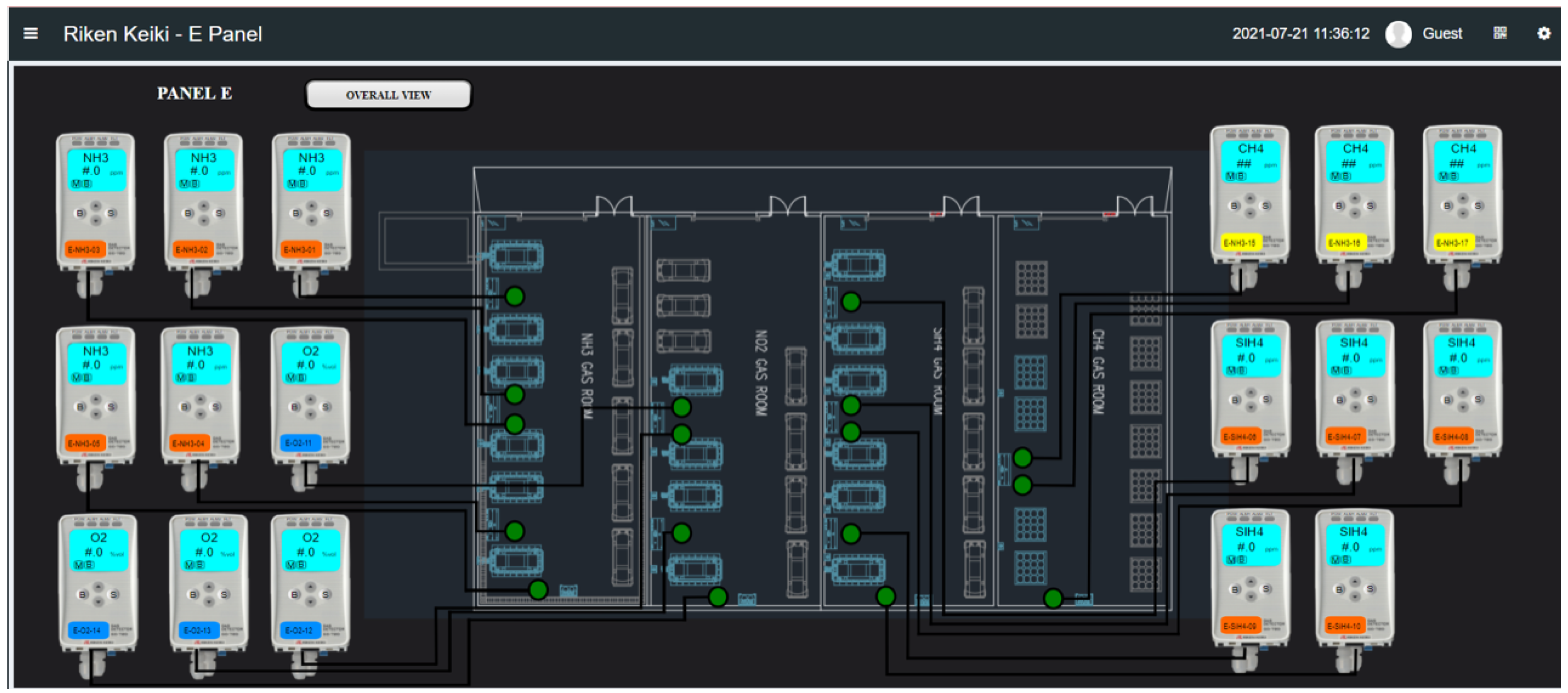
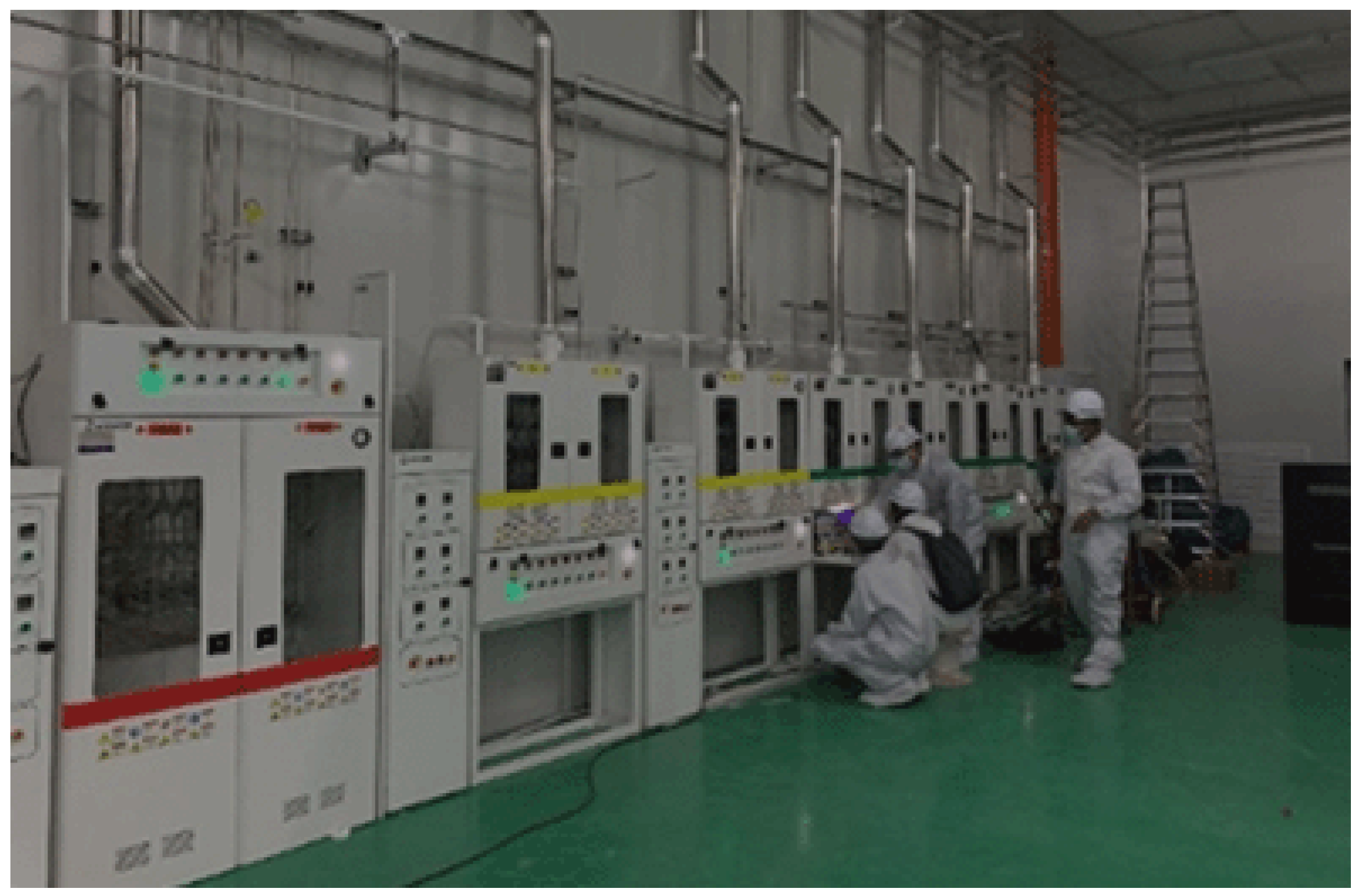
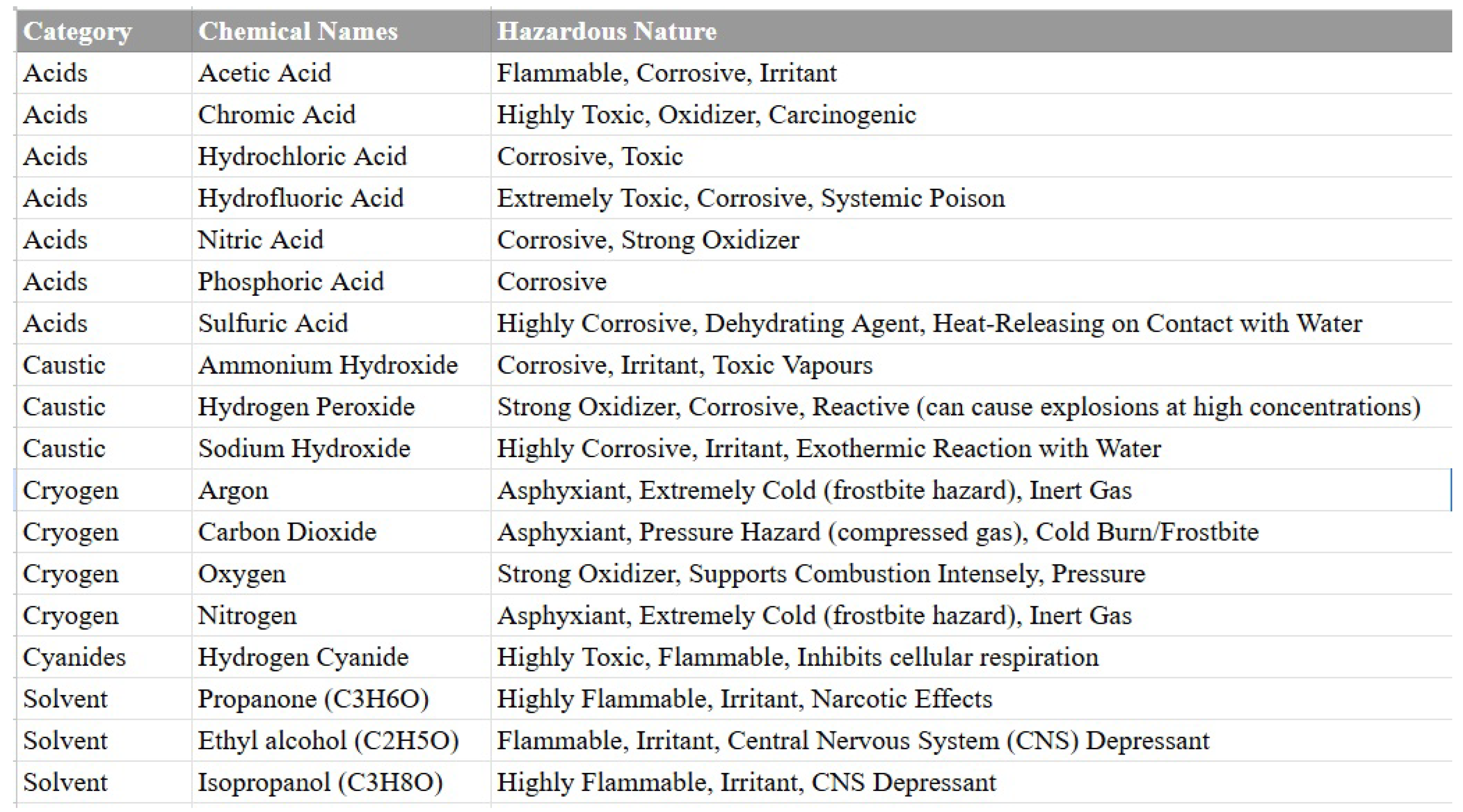
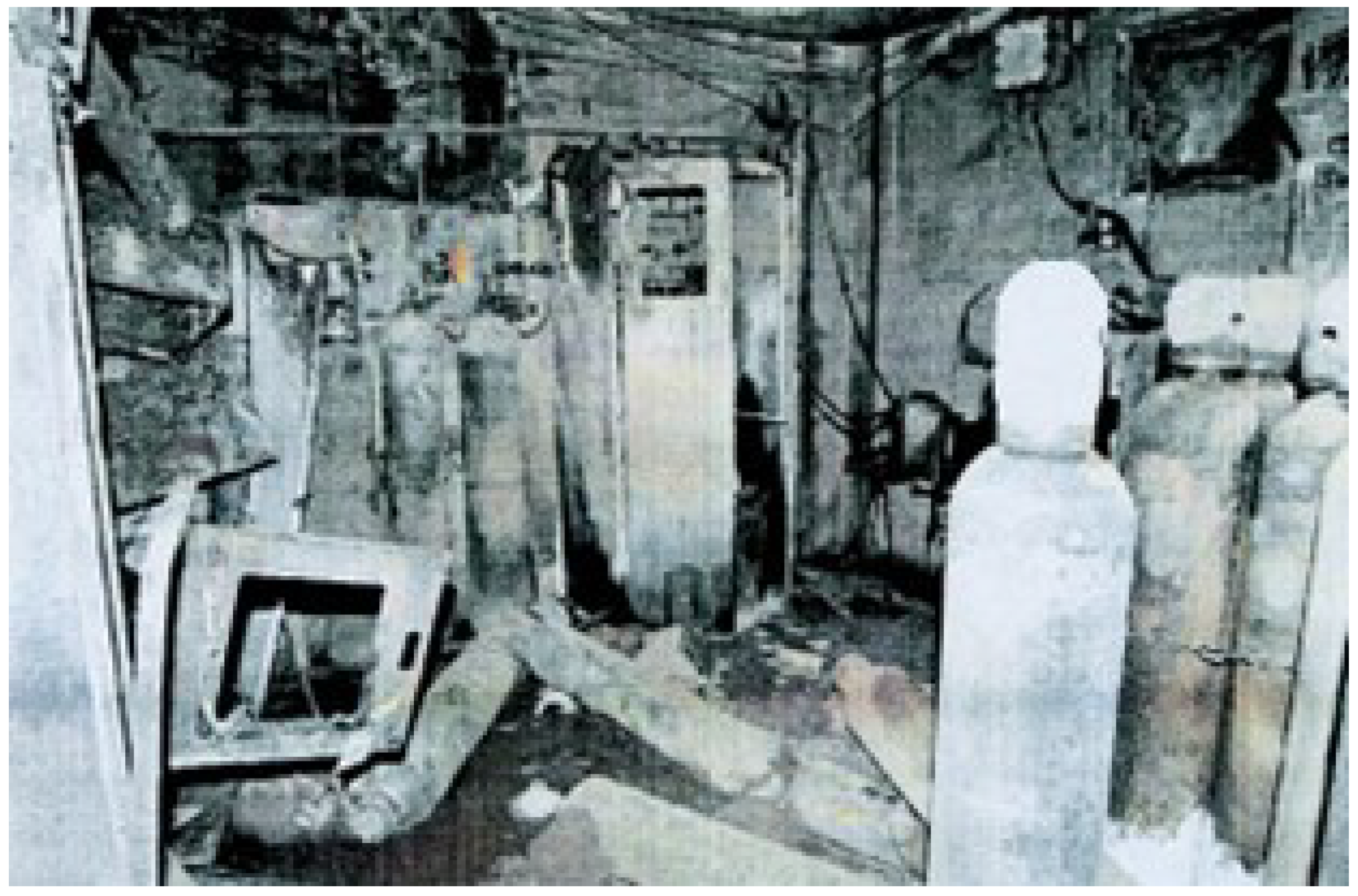
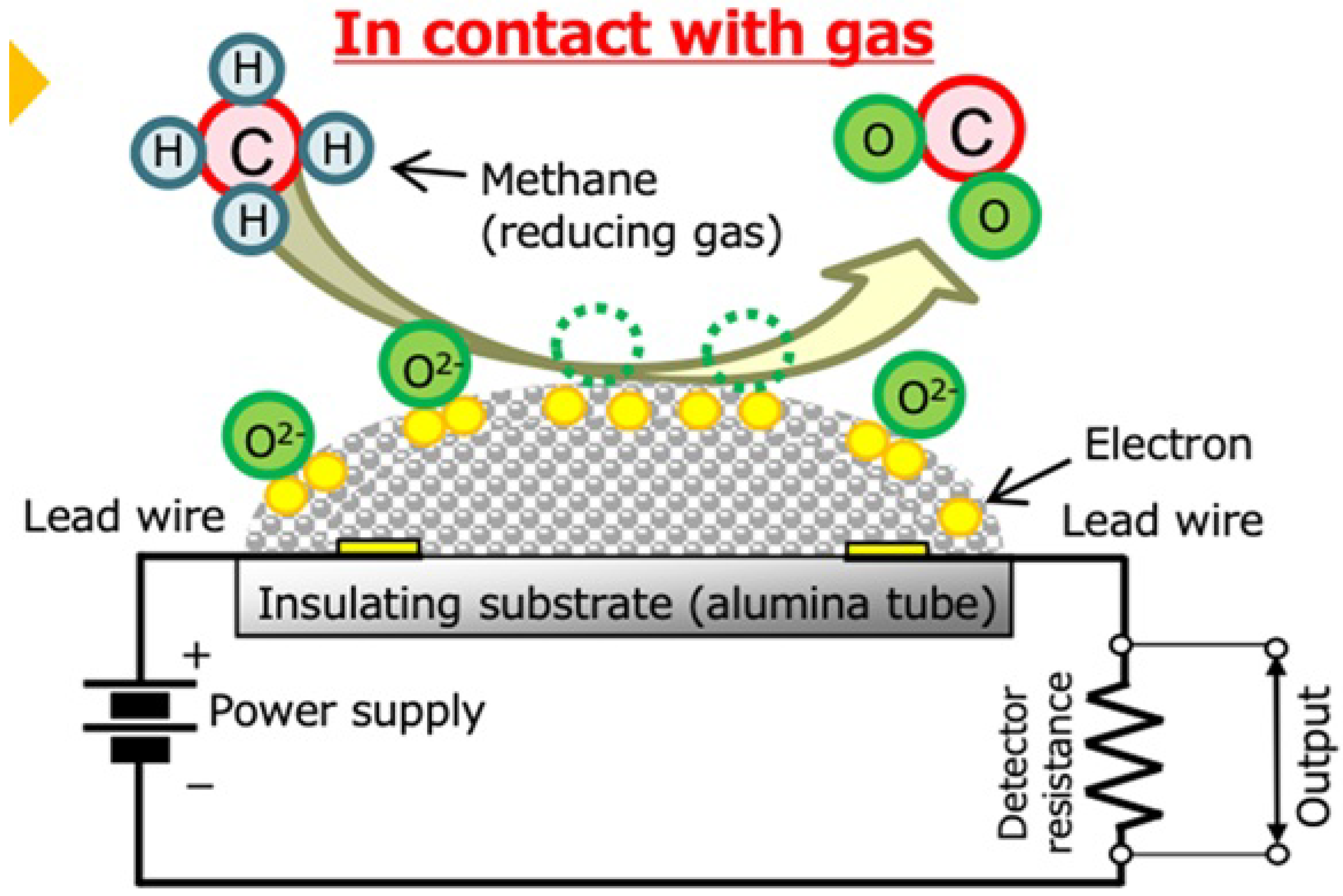


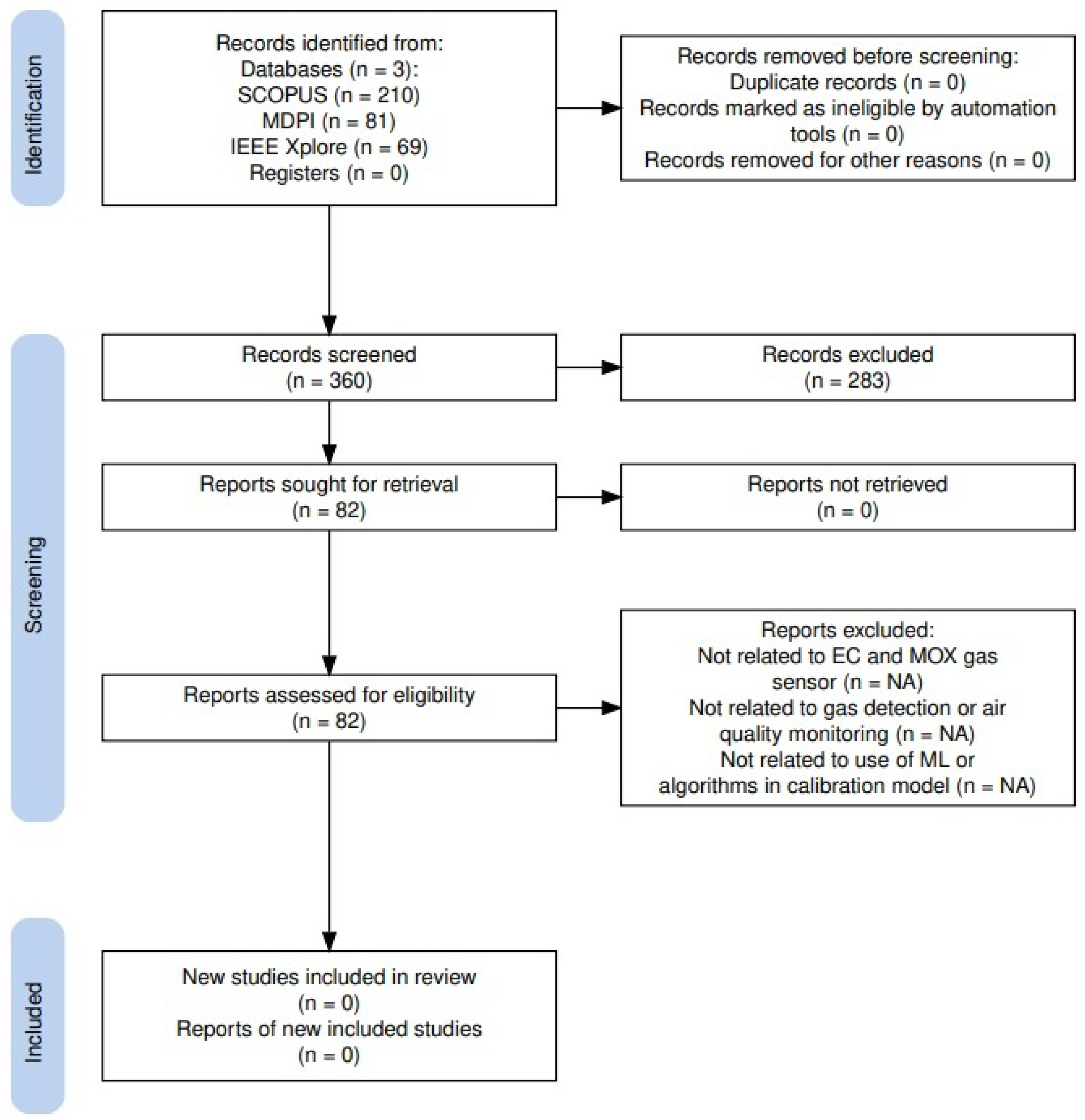
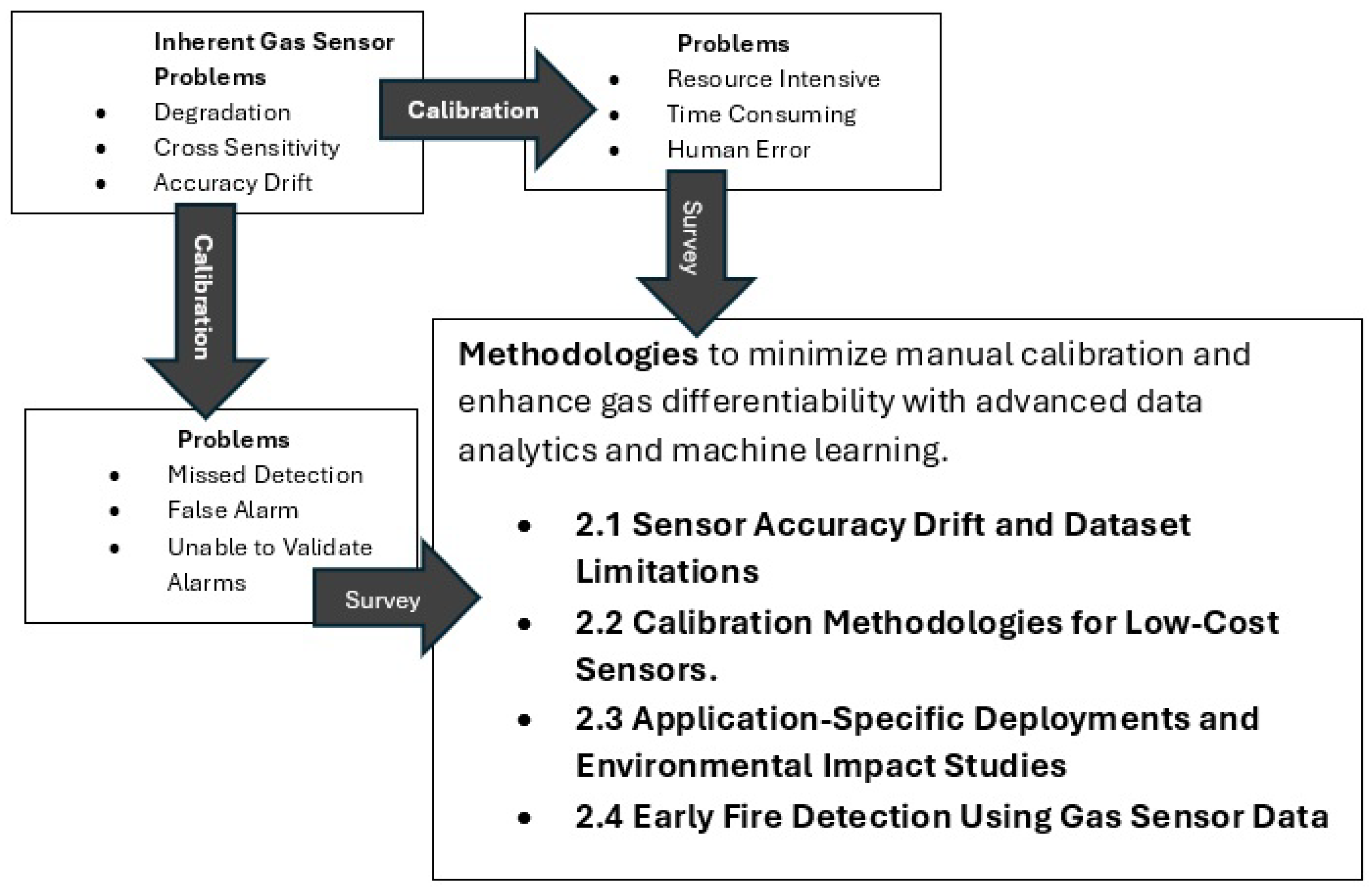

| Calibration Methodology | Objectives |
|---|---|
| Partial Least Squares Discriminant Analysis (PLS-DA) with Genetic Algorithm | To reduce overfitting on general calibration models [29] |
| Support Vector Machine (SVM) Classification and Support Vector Regression (SVR) | To mitigate accuracy drift due to individual sensors [30] |
| Correlation of electrical impedance with sensitivity | To monitor sensor aging vs. response time [31] |
| Correlation of UAV rotor speed with calibration accuracy | To advance UAV gas sensing via a practical calibration method [32] |
| Correlation of temperature and humidity on temperature-induced baseline study | To study the linearity between gas reading and ambient conditions [33] |
| To study the sensor’s long-term stability [34] |
| Applications | Environmental Variables |
|---|---|
| NO2 monitoring along highway | Pollutant, temperature and humidity [35] |
| CO monitoring in tropical environment | Temperature and humidity [36] |
| Ambient air | interference gases, humidity [37] |
| Gas leak detection with Assistant Personal Robot (APR) | Interference gases [38] |
| Detect spoilage-related gases in food packaging | Interference gases [39] |
| Gas detection in air flow | Gas/air flowrate [40] |
Disclaimer/Publisher’s Note: The statements, opinions and data contained in all publications are solely those of the individual author(s) and contributor(s) and not of MDPI and/or the editor(s). MDPI and/or the editor(s) disclaim responsibility for any injury to people or property resulting from any ideas, methods, instructions or products referred to in the content. |
© 2025 by the authors. Licensee MDPI, Basel, Switzerland. This article is an open access article distributed under the terms and conditions of the Creative Commons Attribution (CC BY) license (https://creativecommons.org/licenses/by/4.0/).
Share and Cite
Chew, B.-K.; Mahmud, A.; Singh, H. Autonomous Hazardous Gas Detection Systems: A Systematic Review. Sensors 2025, 25, 6618. https://doi.org/10.3390/s25216618
Chew B-K, Mahmud A, Singh H. Autonomous Hazardous Gas Detection Systems: A Systematic Review. Sensors. 2025; 25(21):6618. https://doi.org/10.3390/s25216618
Chicago/Turabian StyleChew, Boon-Keat, Azwan Mahmud, and Harjit Singh. 2025. "Autonomous Hazardous Gas Detection Systems: A Systematic Review" Sensors 25, no. 21: 6618. https://doi.org/10.3390/s25216618
APA StyleChew, B.-K., Mahmud, A., & Singh, H. (2025). Autonomous Hazardous Gas Detection Systems: A Systematic Review. Sensors, 25(21), 6618. https://doi.org/10.3390/s25216618






